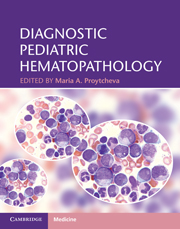Book contents
- Frontmatter
- Contents
- List of contributors
- Acknowledgements
- Introduction
- Section 1 General and non-neoplastic hematopathology
- Section 2 Neoplastic hematopathology
- 10 Chromosome abnormalities of hematologic malignancies
- 11 Expression profiling in pediatric acute leukemias
- 12 Myeloproliferative neoplasms
- 13 Myelodysplastic/myeloproliferative neoplasms
- 14 Myelodysplastic syndromes and therapy-related myeloid neoplasms
- 15 Acute myeloid leukemia and related precursor neoplasms
- 16 Hematologic abnormalities in individuals with Down syndrome
- 17 Precursor lymphoid neoplasms
- 18 Advances in prognostication and treatment of pediatric acute leukemia
- 19 The effect of chemotherapy, detection of minimal residual disease, and hematopoietic stem cell transplantation
- 20 Pediatric small blue cell tumors metastatic to the bone marrow
- 21 Pediatric mature B-cell non-Hodgkin lymphomas
- 22 Pediatric mature T-cell and NK-cell non-Hodgkin lymphomas
- 23 Hodgkin lymphoma
- 24 Immunodeficiency-associated lymphoproliferative disorders
- 25 Histiocytic proliferations in childhood
- 26 Cutaneous and subcutaneous lymphomas in children
- Index
- References
13 - Myelodysplastic/myeloproliferative neoplasms
from Section 2 - Neoplastic hematopathology
Published online by Cambridge University Press: 03 May 2011
- Frontmatter
- Contents
- List of contributors
- Acknowledgements
- Introduction
- Section 1 General and non-neoplastic hematopathology
- Section 2 Neoplastic hematopathology
- 10 Chromosome abnormalities of hematologic malignancies
- 11 Expression profiling in pediatric acute leukemias
- 12 Myeloproliferative neoplasms
- 13 Myelodysplastic/myeloproliferative neoplasms
- 14 Myelodysplastic syndromes and therapy-related myeloid neoplasms
- 15 Acute myeloid leukemia and related precursor neoplasms
- 16 Hematologic abnormalities in individuals with Down syndrome
- 17 Precursor lymphoid neoplasms
- 18 Advances in prognostication and treatment of pediatric acute leukemia
- 19 The effect of chemotherapy, detection of minimal residual disease, and hematopoietic stem cell transplantation
- 20 Pediatric small blue cell tumors metastatic to the bone marrow
- 21 Pediatric mature B-cell non-Hodgkin lymphomas
- 22 Pediatric mature T-cell and NK-cell non-Hodgkin lymphomas
- 23 Hodgkin lymphoma
- 24 Immunodeficiency-associated lymphoproliferative disorders
- 25 Histiocytic proliferations in childhood
- 26 Cutaneous and subcutaneous lymphomas in children
- Index
- References
Summary
Introduction
Myelodysplastic/myeloproliferative neoplasms are hematopoietic diseases with features of both myelodysplastic syndrome (MDS) and myeloproliferative neoplasm (MPN). In the past, these disorders were grouped as MDS, but they are now grouped as a distinct subentity in the latest classification scheme of hematopoietic neoplasms by the World Health Organization (WHO) [1, 2]. The MDS/MPN category includes chronic myelomonocytic leukemia (CMML), atypical chronic myeloid leukemia (aCML), juvenile myelomonocytic leukemia (JMML), and myelodysplastic/myeloproliferative neoplasm, unclassifiable. This chapter will focus on JMML, which is unique to the pediatric population. CMML in children is considered a secondary or therapy-related MDS [3], and aCML does not occur in the pediatric population [4].
Juvenile myelomonocytic leukemia (JMML)
Synonyms
Juvenile chronic myelomonocytic leukemia, juvenile chronic myeloid leukemia, juvenile granulocytic leukemia, monosomy 7 syndrome, infantile monosomy 7 syndrome.
Epidemiology
JMML is a rare disorder with an incidence of 0.6 per 1 million children, and represents approximately 1.6% of childhood leukemias [5, 6]. The age of presentation ranges from 0 to 11 years, with 40%, 90%, and 98% of the cases presenting at under 1, 4, and 10 years of age, respectively [7, 8]. Boys are affected more frequently, with a male to female ratio of 2 : 1.
- Type
- Chapter
- Information
- Diagnostic Pediatric Hematopathology , pp. 245 - 252Publisher: Cambridge University PressPrint publication year: 2011



